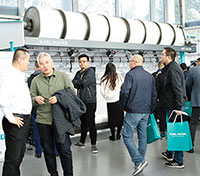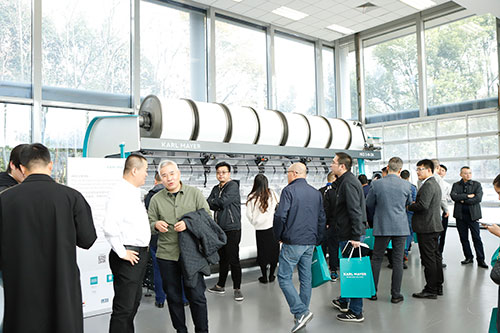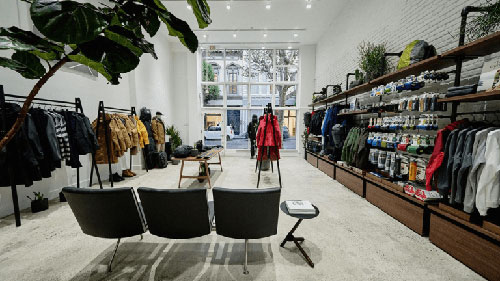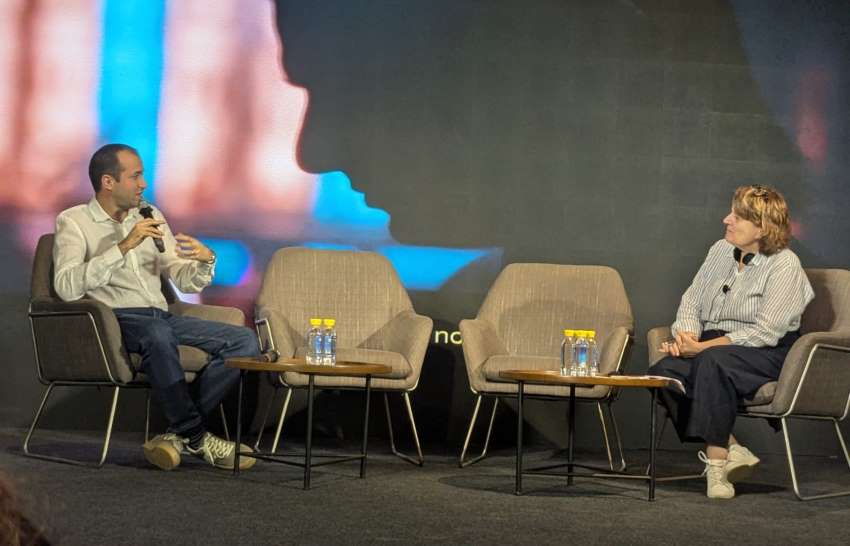FW
Century Textiles & Industries stock have zoomed 30 per cent in the past two months following the demerger of the cement division and its merger into UltraTech Cement.
Post demerger, its debt/ebitda (earnings before interest, tax, depreciation and amortisation) ratio is at a healthy 1.85, paving the way for further growth in the businesses. After demerger, Century Textiles & Industries has three divisions (textiles, pulp and paper and real estate) and the cement division has been demerged along with associated liabilities including a debt of around Rs 3000 crores. This transaction aims at deleveraging the company’s balance sheet and creating an opportunity for its new phase of growth in the remaining businesses with a primary focus on real estate. It also achieves unlocking of the value of the cement divisions to its shareholders through issuance of equity shares of UltraTech directly to shareholders of the company.
Meanwhile, the company’s outlook for both paper and textile sector is positive and it expects to reverse this trend in the second half of the financial year. The management is confident of sustaining and improving its performance in the second half of the year on the back of revenue enhancement measures and a continued focus on operational efficiencies and cost control.
Bangladesh’s income from garment exports has fallen in the July-November period of this fiscal compared to the same period of the earlier fiscal. This has been attributed to falling demand in the Eurozone, the country’s main market for garment products, and a slump in business competiveness of the sector.
Bangladesh garment exporters want cash incentives. While the country’s apparel exports have taken a hit in recent months those of its competitors are on the rise. The readymade garment sector accounts for more than 80 per cent of the country’s annual export earnings. But the country has lost its market share in global apparel exports by 0.1 percentage point to 6.4 per cent. China still remains the top exporter of apparel products with earnings. India’s market share has come down to 3.3 per cent from 4.1 per cent.
The second biggest apparel exporter globally, the Bangladesh garment manufacturing sector is not having the best of times lately. In the last seven months, 59 garment factories have gone out of business while around 25,900 workers have lost their jobs. Most garment factories are small and medium enterprises and they fail to maintain compliance strictly and pay their workers under the new wage structure.
Browzwear and YKK Corporation today announced that YKK’s fastening products will be integrated with Browzwear’s pioneering 3D solutions for the fashion industry. The integration will enable designers to easily incorporate 3D models of YKK products into their designs, freely moving and visualizing them in photo-realistic 3D as they create. Additionally, the specifications for the fasteners will be included in Browzwear’s Tech Pack with the rest of the manufacturing instructions, making the production process faster and error-free.
YKK, a global leader in fastening solutions, including zippers, plastic hardware, hook and loop fasteners, webbing tapes, and snaps and buttons, is among the growing number of prominent companies in the industry to partner with Browzwear to facilitate the creative design and speed time to market. Both companies also share a commitment to driving innovations for more sustainable processes and practices for apparel businesses.
“At Browzwear, we are constantly building partnerships and developing new solutions that will streamline the design process for our clients from concept to commerce,” said Sharon Lim, co-founder, and CEO of Browzwear. “A zipper may seem simple, but designing and manufacturing with that zipper is actually complex. With YKK’s products available in our platform in true-to-life 3D, we’re changing that, and we feel confident that our customers will benefit from the ability to work faster and smarter.”
Browzwear, which shares YKK’s vision for a more innovative, sustainable and efficient fashion industry, is an ideal partner for us. We look forward to working closely with the company to build pioneering solutions that will achieve those goals.” said Takashi Tsukumo, Vice President, Global Marketing Group, YKK Corporation. The first stage of the YKK integration will be available in the January product update. The YKK catalog will be incorporated in phases, with new products added in each of Browzwear’s software updates.
"In its recent show at Shanghaitex 2019, Karl Mayer welcomed around 400 guests from over 220 textile companies at its location in Changzhou. Most of these visitors came from China. But some of them also came from Turkey, Taiwan, Indonesia, Japan, Pakistan and Bangladesh. Despite the current difficult economic policy conditions, the mood during the event was good"
 In its recent show at Shanghaitex 2019, Karl Mayer welcomed around 400 guests from over 220 textile companies at its location in Changzhou. Most of these visitors came from China. But some of them also came from Turkey, Taiwan, Indonesia, Japan, Pakistan and Bangladesh. Despite the current difficult economic policy conditions, the mood during the event was good.
In its recent show at Shanghaitex 2019, Karl Mayer welcomed around 400 guests from over 220 textile companies at its location in Changzhou. Most of these visitors came from China. But some of them also came from Turkey, Taiwan, Indonesia, Japan, Pakistan and Bangladesh. Despite the current difficult economic policy conditions, the mood during the event was good.
In the lingerie sector, the RJ 5/1, E 32, 130 from the new commodity product line was shown. Convincing arguments of the newcomer: a very good price-performance ratio and products that minimize the making-up effort. This includes especially plain Raschel fabrics with seamlessly incorporated, lace-like decoration tapes, which do not require hem on leg cutouts and waistband. The first machines are currently being negotiated with customers in China. Several specific project discussions were held during the in-house show. For the manufacturers of shoe fabrics, the company presented the fast RDJ 6/1 EN, E 24, 138” offering wide-ranging patterning possibilities.
Representatives of the home textile industry were impressed by the WEFT
FASHION TM 3, E 24, 130 displayed at Changzhou. The weft-insertion warp knitting machine produced a fine, transparent product with an irregularly puffed-up fancy yarn. The finished curtain article resembles a woven fabric in its look but is produced much more efficiently and without the elaborate sizing process. Visitors from the important curtain country of Turkey, as well as many manufacturers from China, were particularly interested in the patterning possibilities of this machine. A first WEFT. FASHION TM 3 will start production here in early 2020.
Technical Textiles
KARL MAYER Technische Textilien was also satisfied with the results of the in-house show. The company exhibited weft-insertion warp knitting machine TM WEFT, E 24, 247 which should become further established as production equipment with an outstanding price-performance the ratio for manufacturing interlinings in a volatile market environment. In Changzhou, the machine attracted a lot of attention.
Warp Preparation
The Warp Preparation Business Unit had a small but select group of visitors with specific interests and questions about the exhibited machines. On show was an Isodirect 1800/800 and, thus, a value-for-money direct beamer for the mid-range segment. The model impressed by a beaming speed of up to 1,000 m/min and high beam quality. Six Isodirect models had already been ordered in China, one of which started operation at the end of 2019. The exhibited machines were complemented by the CSB Size Box, the core of the Isosize sizing machine. The innovative Size Box operates with rollers in linear arrangement according to the principle„3 x immersing and 2 x squeezing“, ensuring the highest sizing quality.
"The desire to learn about popular international fashion amongst US consumers is encouraging international labels like Rouge and Ganni to set up bases in the country. One of the first brands to eye the US market, London-based jewelry brand Missoma generates around 20 per cent of its sales from the US"
 The desire to learn about popular international fashion amongst US consumers is encouraging international labels like Rouge and Ganni to set up bases in the country. One of the first brands to eye the US market, London-based jewelry brand Missoma generates around 20 per cent of its sales from the US.
The desire to learn about popular international fashion amongst US consumers is encouraging international labels like Rouge and Ganni to set up bases in the country. One of the first brands to eye the US market, London-based jewelry brand Missoma generates around 20 per cent of its sales from the US.
Similarly, Brazil-based mega brand Farm Rio eyes the US market as its first step towards global expansion. The brand has already achieved success in this market through its partnerships with brands like Adidas and Anthropologie.
Much like these two brands, other native brands like Glossier, Mejuri, or Golde have also established an emotional and human connection with their customers. They are learning about all the important cultural events in the country that fuels their creativity besides inspiring confidence and encouraging collaborations with local brands.
Culture, customisation, practicality inspire American clothes
As for shopping habits, American consumers are a lot savvier and curated. They seek an easy point of sale and look for the best deal as against UK, shoppers who are more likely to go directly to the site. For these brands, holiday sales like Labor Day and Black Friday are much more important.
US shoppers also like customised products. They like their products to have a personal touch as against Europeans who adopt an impersonal attitude to their clothes. The US market also challenges brands to consider practical elements of design in addition to culture. This is evident from the fact that Brazilian brand Farm Rio tailors its collection to the US market and the distinct differences between the two countries in climate, seasons, lifestyle and culture. The brand introduced its first-ever fall collection this season, to cater to the colder climate that one doesn’t experience in Brazil. It’s cool-weather collection is infectiously colorful with tropical-inspired puffer coats emerging as the favorite amongst US women.
Department stores, multi-retailer website guard emerging brands
Though VC-funded direct-to-consumer brands have become major disruptors of the US retail space, department stores and multi-retailer sites continue to guard emerging brands. This is evident from the recent success of Net-a-Porter's Vanguard program, an incubator that helped launched buzzy labels like Peter Do and Ratio Et Motus.
Similarly, Missoma, a DTC brand, partnered exclusively with Nordstrom to help growth in states. Farm Rio has also partnered with Shopbop to create awareness amongst its loyal shoppers across the country. Since these brands are expert curated, a site like Shopbop offers consumers an opportunity to learn about these national and international brands.
Pantone, provider of professional color language standards and digital solutions, and X-Rite have named Pantone 19-4052, Classic Blue, as the Pantone Color of the Year for 2020. The Color of the Year is selected after a detailed trend analysis. Pantone’s color experts at the Pantone Color Institute comb the world looking for new color influences.
Imbued with a deep resonance, Pantone 19-4052 Classic Blue provides an anchoring foundation. It brings a sense of peace and tranquility to the human spirit, offering refuge. Aiding concentration and bringing laser-like clarity, Pantone 19-4052, Classic Blue re-centers thoughts. A reflective blue tone, Classic Blue fosters resilience. Non-aggressive and easily relatable, it lends itself to relaxed interaction.
The Pantone Color of the Year highlights the relationship between trends in color and what is taking place in our global culture at a moment in time, a color that reflects what individuals feel they need that color can hope to answer. The selection provides strategic direction for the world of trend and design, reflecting the Pantone Color Institute’s year-round work doing the same for designers and brands.
EU-funded SMART Textile and Garment project is holding a conference at the Sedona Hotel in Yangon and will see a good presence of brands, trade unions and business heads.
The project aims to deliver on-site assessments and trainings on key topics like workplace communications and human resource management systems. And the training will be provided by local and European industry experts. There will be special training programs on occupational safety and health, chemicals and waste management too.
SMART Myanmar has been actively involved with Myanmar Garment Manufacturers Association (MGMA) for some time now. The project has been able to conduct training and consultancy programs with 299 garment, textile and footwear factories since 2016, which resulted in bringing thousands of improvements related to safe workplaces, effective HR management and energy efficiency. The new project intends to take the efforts and commitment forward.
After a relatively optimistic year, a new report by Business of Fashion (BoF) and The McKinsey Global Fashion Index forecasts growth of the global fashion industry to decline by 3 to 4 per cent in 2020. This will pressurise brands to perform and fine-tune their customer base.
With the first scoops on talent and resources going to the top 20 players such as Nike, adidas, Pandora and H&M who make up majority of the industry’s profit, smaller brands are at a high risk of falling behind.
While the digital age has primed consumers to expect a quick and easy service it also opens up new opportunities for engagement. By utilising social media strategies to create eye-catching posts and keeping up to date with new technologies that make the shopping experience seamless, brands may stand a chance in 2020.
BoF lists some other useful strategies such as improving in-store experience, creating sustainable products, and championing important values such as diversity and inclusion.
The European Union wants Bangladesh to address outstanding labor issues including freedom of association in export processing zones (EPZs). The EU already grants Everything But Arms (EBA) privileges to Bangladesh. The EU is working with Bangladesh on GSP Plus issues.
Bangladesh expects to face enormous challenges in adjusting to the fourth industrial revolution and robotics technologies. Bangladesh is the second largest exporter of readymade garments in the world. About 58 per cent of Bangladesh’s garment exports go to EU countries. Bangladesh wants to graduate from LDC status by 2024. But once this happens it may lose the EBA facilities. The country has urged the EU to continue providing GSP Plus trade facilities for Bangladesh. One challenge Bangladesh faces is that the export basket is restricted to garments. Bangladesh wants EU foreign direct investment and technologies in other promising export sectors such as agro-processing, shipbuilding, information and communication technology and pharmaceuticals in order to move up the value chain and enable a win-win benefit. The EU has also been invited to invest in special economic zones in Bangladesh. Both are joining hands to address impediments to more FDI from EU countries to Bangladesh. Several rounds of dialogue have resolved some outstanding issues.
The European Union is working with more than a 100 garment and textile factories in Myanmar in expanding training and capacity building programs for social and environmental performance.
The Smart Myanmar project, which will feature the involvement of local and European experts, will deliver on-site assessment and training on topics such as human resource management systems and workplace communications, occupational safety and health, chemicals and waste management, and energy efficiency. The aim is to improve work conditions, strengthen sustainable production practices and responsible supply chains and foster responsible business practices in Myanmar.
Smart Myanmar has been working with garment factories since 2013 to promote sustainable consumption and production of garments – a concept with an emphasis on resource efficiency and social responsibility. In fiscal year 2018-19, Myanmar-made garments were among the largest export categories in the country. Since 2013, Myanmar’s garment sector has shown staggering export-oriented growth. The garment industry serves largely the European market and has created job opportunities for thousands, mostly women. Europe is one of the world’s largest consumer markets. European consumers pay a lot of attention to where the products they buy come from and how they are produced. Sustainable production and respect for international labor standards are therefore important topics in the EU’s trade relations with Myanmar.












